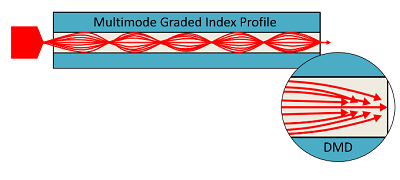101 Series: What is Modal Bandwidth?
March 7, 2018 / General, 101 learning
Often when we hear the term “bandwidth” we think of how much data can be sent over a fiber link. But when we look at fiber specifications, we typically see a specification for modal bandwidth, or effective modal bandwidth (EMB). This key characteristic of multimode fiber refers to how much data a specific fiber can transmit at a given wavelength, and it is dependent on another characteristic—differential mode delay.
In this 101 Series of Cabling Chronicles, let’s try to make a little sense of modal bandwidth.
DMD Dependent
EMB is measured as Megahertz over 1 Kilometer, expressed as MHz*km. A 200 MHz*km fiber can move 200 MHz of data up to one kilometer. And it works vice versa—a 200 MHz*km fiber can also be defined as moving 100 MHz of data up to two kilometers. So a higher EMB supports transmission at a given rate over longer distances. For example, OM3 fiber has an EMB of 2000 MHz*km while OM4 has an EMB of 4700 MHz*km. This makes sense since OM3 can only support 10 Gig up to 300m while OM4 fiber can support 10 Gig to 550m. It’s important to note that modal bandwidth is not something you can test in the field – it is a standards-based requirement and the rating is found in a vendor’s spec sheet.
Modal bandwidth is dependent on the differential mode delay of a fiber, or DMD, which is the primary bandwidth-limiting factor of multimode fiber. When multiple modes of light travel through a multimode fiber, some travel down the center, while others travel along pathways closer to the core-cladding interface. Those travelling on the outside edge are referred to as higher order modes, while those near the center of the core are lower order modes. Higher and lower order modes travel at different velocities, and DMD is the difference in travel time. The smaller the DMD, the less the light pulses spread out over time and the higher the bandwidth.

To limit DMD, today’s multimode fiber is designed with a graded fiber index profile that creates a parabolic (i.e. symmetrical curve) pathway. This allows the lower order modes travelling shorter distance close to the core of the fiber to travel slower, and the higher order modes travelling longer distances near the edge of the core to travel faster. This minimizes time delays between pulses, decreasing DMD and allowing for higher bandwidth.
There are two standards-compliant options for testing modal bandwidth—the minEMB method and the DMD mask method. Even better is when fiber manufacturers rely on both methods.
The Secret of Min
While DMD impacts bandwidth, overall fiber performance is also a function of the transceiver light sources. With higher speeds came a shift from slower and wider LED light sources that flooded a fiber’s core to higher speed laser-based light sources such as vertical-cavity surface-emitting lasers (VCSELs) that emit a much narrower beam of light. However, standards-compliant VCSELs include a range where some lasers might concentrate power more towards the center of the fiber core than others, which results in different bandwidth results on the same fiber. In fact, there are 10 different VCSEL sources defined by TIA standards to represent the range of output power characteristics allowed.
To solve this problem, some fiber manufacturers use a minEMBc measurement that is calculated using DMD calculations for all ten of the different VCSEL options, with the lowest outcome providing the minimum performance. According to some fiber manufacturers, this guarantees performance over the entire range of standards-compliant transceivers, and is therefore considered a much better representation of bandwidth than looking at DMD alone, which does not account for various VCSEL characteristics.
Behind the Mask
Other fiber manufactures strongly believe that the DMD mask method is a better way to calculate a fiber’s performance. While both minEMB and the DMD mask method rely on DMD measurements, it’s how that measurement is used that is the difference.
The DMD mask method compares DMD test results against a set of specifications, referred to as templates or masks to determine if the fiber effectively controls modal dispersion – upon which true performance depends. To meet the EMB target for a specific fiber type, the fiber must conform to one of the DMD masks. According to standards, a fiber meeting any of the masks for that fiber type will meet the required minimum EMB.




